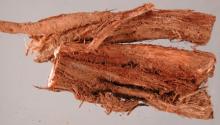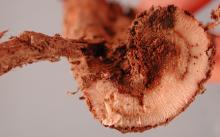Cause A fungus, Phomopsis tuberivora (syn. Phacidiopycnis tuberivora), that can survive in plant debris, on hop plants, or in soil as sclerotia. The fungus needs injured hop tissue for infection to occur. This disease was first reported in Australia in 1981 and recently confirmed in a hop yard in the Pacific Northwest in 2013. It usually takes more than one growing season to notice the problem, and cone yield and alpha-acids can be affected.
Symptoms Plants appear weak and yellowish. Rhizomes and roots have a twisted growth. The bark covering these affected root systems thickens, becomes loose, and brownish in color. Internal tissues turn dry and turn orange to red, crumbling easily. There is a well-defined lesion margin, and it may appear water-soaked with a pinkish coloration in the adjacent healthy tissue.
Cultural control
- Propagate from cuttings free of the fungus.
- Avoid mechanical crowning.
Reference Gent, D.H., Mueller-Warrant, G., Woods, J.L., Putnam, M.L., and Twomey, M.C. 2018. Red crown rot of hop in Oregon caused by Phomopsis tuberivora. Plant Health Progress https://doi.org/10.1094/PHP-2013-0624-01-BR.


